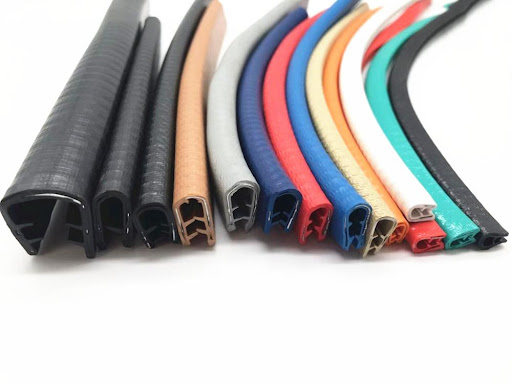Rubber edging strip is a highly flexible ethylene propylene diene monomer synthetic rubber which is used to expose and finish exposed metal edges. It has excellent resistance against wear and ozone that fits most tight radius applications. Rubber edging strip is ideal for sharp edges, boats, sheet metals, playground equipment, cabinets and more.
These strips are also known as extruded rubber products that are used to seal a surface from the elements. They are used on doors and windows to protect against cold air. They are available on a wide range of products and a variety of rubber compounds.
Types of Strips
-
EPDM STRIP
This strip resists moisture and adaptable to extreme temperatures. It maintains its flexibility at low temperatures too and provides resistance against UltraViolet light.
Elastic-proxy offers fire-rated trim that meets tough requirements for flame, smoke and toxicity. This fire-resistant rubber laboratory tests it and validate for mass transit applications such as buses and rail.
-
TPE STRIP
It is made of thermoplastic elastomers, a group of rubber-like materials that combine the processing strengths of thermoplastics with the flexibility of thermoset rubbers.
TPE is less likely to break in cold temperatures than PVC, but has a higher material cost than rubbers.
-
Silicon STRIP
Silicon strip is used in applications that require low toxicity, low reactivity, and thermal stability with a wide range of temperatures. This Silicon strip is used in food and beverage processing, medical, pharmaceutical, and other hygienic applications.
Uses of Rubber Strip
- It protects exposed metal edges and panels.
- It protects, shock absorbs or seals off gaps between objects.
- Rubber strip protects metal surfaces and provides sealing and insulation.
- It contains unique metal clamps and tongue-shaped buckles, which is sturdy and durable.
- It plays a key role in various electrical cabinets.
Disadvantages of Strip
- It has poor tear strength. This improves with the addition of other ingredients, but it doesn’t offer natural strength, so the application carefully assesses for the suitability of silicone as a solution.
- Another disadvantage of strip is that a premium product they can come up with similarly premium price tag material compared with
Top Stripping materials
-
V Strip
Tension seal is a durable plastic or metal strip folded into a V shape that springs open to bridge gaps.
Along the sides of a sliding window; on the top and sides of a door.
-
Felt Strip
It sells in rolls, either plain or reinforced with a pliable metal strip. Though inexpensive, it lasts only a year or two. Around a door or window sash; so that it compresses against the door.
-
Foam
We can make it from open cell foam or EPDM rubber with a sticky back. This type of stripping sells in varying widths and thicknesses, which makes it best for irregular sized cracks
-
Door Sweeps
Door Sweeps are flat pieces of plastic, aluminum, stainless steel fitted with a strip of nylon, plastic, or a sponge to fill the gap between door and threshold.
-
Tubular Rubber
Tubular is an effective air barrier; versions made of a narrow sponge rubber or tubing come attached to a wood. Then, we insert silicone into milled grooves.
Applications of Strips
Rubber edging strip provide good resistance to substances like oil and petroleum, ultra violet lights and oxidizing elements. It has flexibility even in cold temperatures. Its elasticity even makes it short for various kinds of shock absorbers and for machinery designed to reduce vibration.
Footwear, medicine, engineering, railways and marine uses rubber. For example, they act as a lining storage for tanks and tank cars. To prevent tripping, we lay sheets under shower heads and washrooms.
Another important use of the lucrative strip is landscaping. Gardeners and hobbyists use strips to cover and beautify their yard edges. Holders or baskets that contain flowers or gravel also use edging strips to make things look beautiful.
Conclusion
In this article, we discussed edging strip, types, advantages and disadvantages of strip, and applications of strip.

